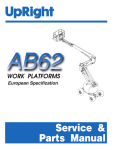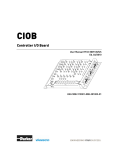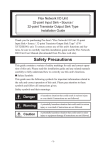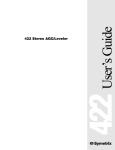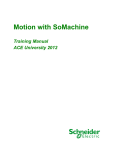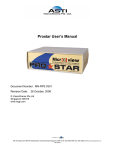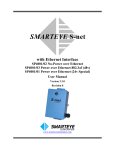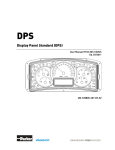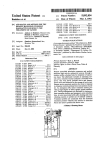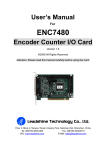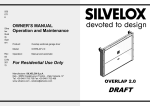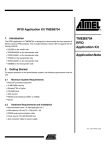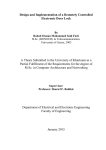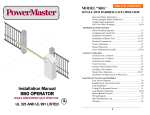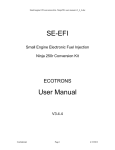Download Beginners Guide to PLC Programming
Transcript
Beginner’s Guide To PLC Programming How to Program a PLC (Programmable Logic Controller) By Neal Babcock Industrial Automation Series engineer-and-technician.com Beginner’s Guide to PLC Programming Copyright © 2013 Modern Media & Automation, LLC engineer-and-technician.com Table of Contents Introduction to PLCs!.............................................................1 Ladder Logic!.........................................................................1 The Dialect of PLCs!..............................................................2 Equivalent Logic!....................................................................4 Scan Time!.............................................................................6 The Automated Drill Press!....................................................7 Sequence of Operation!.........................................................8 Operator Station!...................................................................10 I/O Listing!..............................................................................11 Inputs!....................................................................................11 Outputs!.................................................................................12 Internal Coils!........................................................................12 The Program!.........................................................................13 Machine Safeties!..................................................................13 Pilot Light Test!.......................................................................15 Indicate The System Is Operational!......................................16 Machine Operation Mode!.....................................................16 Run The Spindle Drive Motor!................................................17 Indicate The Spindle Drive Is Running!..................................18 Run The Infeed Conveyor!.....................................................18 Ensure There Are No Parts In The Machine!.........................19 Ensure All Components Are At Home!...................................19 Begin The Cycle!....................................................................20 Lower The Stop Gate!............................................................21 Run The Main Conveyor!.......................................................21 Indicate The Part Is In Place!.................................................22 Clamp The Part In Place!......................................................22 Lower The Spindle!................................................................23 Drilling Operation Is Complete!..............................................24 Return The Spindle To Its Home Position!.............................25 Machine Cycle Is Complete!..................................................26 Fault Detection And System Diagnostics!..............................27 Personnel Safety Guard Door!...............................................27 Low Compressed Air Pressure!.............................................28 Motor Starter Overload!.........................................................29 Latch The Motor Overload Detection!....................................30 Indicate A Motor Overload Condition!....................................31 Jammed Part Detection!........................................................32 Latch The Part Jammed Detection!.......................................33 Indicate A Part Jammed Condition!.......................................33 Monitor The Drill Time!...........................................................34 Summarize The Fault Conditions!.........................................35 13 Marks Of A Well Written Program!....................................36 General PLC Tips!.................................................................37 The Automated Drill Press in RSLogix 500!...........................38 Beginner’s Guide to PLC Programming Copyright © 2013 Modern Media & Automation, LLC engineer-and-technician.com Introduction to PLCs Nearly all the industrial equipment that you find in a modern manufacturing facility shares one thing in common - computer control. The most commonly used controller is the PLC, or the Programmable Logic Controller, using a programming language called Ladder Logic. The language was developed to make programming easy for people who already understood how switches, relay contacts and coils work. Its format is similar to the electrical style of drawing known as the “ladder diagram”. Originally, there were only a few functions available in this language, but as times have progressed, many more higher-level functions have been introduced. We are going to stick to the basic, commonly used functions here. Also, this text will not replace the user's manual that comes with a PLC, but it will give you a big head start if you have never programmed a PLC. This course is intended to provide an introduction to the programming methods used in PLCs and give the reader a solid, basic understanding of the language of Ladder Logic. After you complete this course, you may be interested in learning about hardware-specific software and programming techniques. Modern Media offers a book entitled PLC Programming Techniques How to Program an Allen-Bradley SLC 500 with Rockwell Automation’s RSLogix. This ebook shows, step-by-step, how to create a program from scratch in Allen-Bradley’s RSLogix 500. To learn more, please visit engineer-and-technician.com. Ladder Logic I have summarized the terms and techniques you need to know if you are going to work with ladder logic. It is not a comprehensive summary, as that would take volumes of text, but if you are just starting out, the information in this book will be very helpful. Every PLC programmer, no matter what skill level, must have learned the principles described in this book at one point in time. There is simply no way around it. I have included a program for a simple machine that lets you really understand how Ladder Logic works. To effectively write a program, or even edit one, the programmer must know how to visualize the effects of the changes he will make. In other words, you have to be able to look at the logic “on paper” and imagine how it will work when it is entered into the PLC. This course will teach you how to do that. Beginner’s Guide to PLC Programming Copyright © 2013 Modern Media & Automation, LLC engineer-and-technician.com 1 There are many types of PLCs, and differences among PLCs, but what is discussed here should be common to all types. After you read and understand this, you will have a clear understanding of the structure of this type of programming. In the real world of industrial automation, the methods presented in this document may be all that many people will ever need to know. The Dialect of PLCs Let’s define some terms and symbols: BIT - an address within the PLC. It can be an input, output or internal coil, among others. RUNG - A section of the PLC ladder program that terminates in an output function of some type. HARDWIRED INPUT - a physical connection to the PLC from an input device (switch or sensor, etc.) A hardwired input is labeled INPUT in our example. HARDWIRED OUTPUT - a physical connection from the PLC to an output device (relay or pilot light, etc.) A hardwired output is labeled OUTPUT in our example. INTERNAL COIL This is a programmable bit used to simulate a relay within the PLC. The internal coil has no connection to the outside world. It does not connect to an output card. Internal coils are used to store information. The “contacts” of this “relay” can then be used multiple times in other parts of the program. An internal coil is labeled COIL in our example. --] [-Normally Open Contact When used with a hardwired input, this instruction is off until there is a voltage applied to the input. The bit address then goes high, or on, and the instruction becomes “true.” It works the same way when it has the same address as an internal coil, except that the coil must be turned on by logic in the program. --]/[-Normally Closed Contact This is an inverted normally open contact. When used with a hardwired input, this instruction is "true" until there is a voltage applied to the input. It then goes low, or off, and becomes “false.” It also can be used with an internal coil, becoming true when the coil is off and becoming false when the coil is on. Beginner’s Guide to PLC Programming Copyright © 2013 Modern Media & Automation, LLC engineer-and-technician.com 2 The Automated Drill Press Now let’s jump right into a project. The best way to learn a programming language is to look at a real world example. However, before you can do any programming, you must have a clear understanding of how the machine works. Let’s say a furniture manufacturer needs to drill a 3/8” hole in a certain spot on a piece of wood. The entire process needs to be automatic. The mechanical and electrical engineers bring you an isometric drawing like the one shown here. Mechanical details have been omitted for clarity, as is often the case in a “concept” drawing. The main conveyor will transport the part into the machine where the part will meet a pneumatically actuated stop gate. At that time, another pneumatic cylinder will actuate a clamp that will push the part back against the conveyor wall. This will hold the part in place during the drilling process. Photocells will verify that the part is in position; the spindle will lower and Beginner’s Guide to PLC Programming Copyright © 2013 Modern Media & Automation, LLC engineer-and-technician.com 7 proceed to drill a hole in the part. After the hole has been drilled and the spindle has retracted to its home position, the clamp will release, the stop gate will raise and the part will exit. The cycle then repeats itself for each part that comes down the line. Sequence of Operation Here is a more detailed explanation of the drilling process: When the machine starts, the stop gate lowers and the part is moved into position by the main conveyor. Optical sensors (photoeyes) determine when the part is in place. When the part is positioned correctly, a clamp extends to hold the part in place. Beginner’s Guide to PLC Programming Copyright © 2013 Modern Media & Automation, LLC engineer-and-technician.com 8 The spindle of the drill press is lowered, and the hole is drilled in the part. A sensor in the drill press spindle tells the PLC when the spindle has reached the end of its travel. After the hole is drilled, the spindle retracts, the clamp retracts, the stop gate is lifted and the part is carried out of the machine by the main conveyor. Beginner’s Guide to PLC Programming Copyright © 2013 Modern Media & Automation, LLC engineer-and-technician.com 9 The Program Now that you understand what has to be done and how it is to be accomplished by the mechanical equipment, you can begin writing the program. The text in the fixed font is basically the information that you would see if you were looking at the monitor of the computer or a printout. In actual practice, the fonts used in PLC software vary widely. For the purposes of this book, we want to easily differentiate the program logic from our explanations of the logic. A series of asterisks (*****) indicates a "rung comment." This is descriptive text added to the program, and is seen on the programming monitor, but has no affect on the logic. For purposes of this manual, I have placed additional explanations between rungs. Use a title to name the program and include any general information. | | | | | | ____________________________________________________________ | | | AUTOMATIC DRILL PRESS MACHINE CONTROL | | PRODUCTION LINE #3 | | REVISION 2 | |__________________________________________________________| Machine Safeties It is best to start a program by evaluating any safety switches and setting a master bit. This type of bit is what we call an internal coil. It has no hardwired connection to the outside world. In this case, a latch is used to set an internal “System Running” bit. The “latch” is accomplished by putting a normally open contact around the Start System pushbutton input. If the emergency stop is clear, and the machine guard is in place, and there is no system fault the operator may press the start button to set the latch. If the stop button is pushed or a previous conditions ceases to exist, the “System Running” latch will drop out. Most of the time, the order of the bits in a rung doesn't matter. We could have rearranged any of the bits in this rung, though we would still have to put the latch around the Start pushbutton. The PLC wouldn't care and the output coil would still respond the same. However, to make the rung easier to read, I try to place bits from left to right in order of importance. If the E-Stop is not cleared, then nothing else should matter anyway. Having the safety guard in place is more important than a system fault. Now, if those requirements have been met, we can press the start button. And we don't care about the stop button until we have pushed the start button. Beginner’s Guide to PLC Programming Copyright © 2013 Modern Media & Automation, LLC engineer-and-technician.com 13 Run The Spindle Drive Motor This rung turns on the drill press spindle motor. It will come on immediately in automatic mode, but it can also be controlled by the “Start Press” and “Stop Press” switches in manual mode. | ***** Run the spindle drive motor of the drill press. A | manual mode is provided to allow ease of set-up. | | | Run Drill |System in Press |Auto Mode MS5 | COIL4 OUTPUT5 7 [---] [-----------------------+----------------------------( OUT ) | | |SystemIn Start Stop | |Manual Press Press | |Mode PB6 PB7 | | COIL5 INPUT6 INPUT7 | [---] [---+---] [---+---] [---+ | | | | |Run Drill| | |Press | | |MS5 | | | OUTPUT5 | | +---] [---+ | Beginner’s Guide to PLC Programming Copyright © 2013 Modern Media & Automation, LLC engineer-and-technician.com 17 Low Compressed Air Pressure It is a good idea to keep track of the compressed air pressure. The machine will not operate properly if there is insufficient air pressure. You can put it on a fairly long time delay, because you don't care about momentary drops in pressure, like a second or two. But when it does drop beyond the lower limit for enough time, you want the machine to stop. You also want it to latch so you know why the machine stopped running. The air pressure could come back up before the operator sees the pilot light, and he would be left scratching his head. The latch is reset by the Reset System pushbutton. | ***** Detect abnormally low compressed air pressure. | | |AirPressr +--Air -+ |Normal | Pressure | |PS27 | Abnormal | | INPUT27 TIMER27 | 22 [---]/[-------------+---------------------------------+---4SEC-----+ | | |Air Reset | |Pressure System | |Abnormal PB1 | | TIMER27 INPUT1 | [---] [-------]/[---+ | | | ***** Indicate abnormally low air pressure. | |Air Low Air |Pressure Pressure |Abnormal PL26 | TIMER27 OUTPUT26 23 [---] [---+-------------------------------------------------( OUT ) | | |Pilot | |Light | |Test | | COIL2 | [---] [---+ Beginner’s Guide to PLC Programming Copyright © 2013 Modern Media & Automation, LLC engineer-and-technician.com 28 Motor Starter Overload If the auxiliary contacts in the motor starters don't pull in after one second, there is some kind of problem. You have to look at each one individually. | ***** The starter is assumed to be overloaded if the aux | contact does not pull in after 1 second. | |RunInfeed InfedConv +--Infeed -+ |Conveyor Running | Conveyor | |MS1 MS1AUX | Overload | | OUTPUT1 INPUT20 TIMER1 | 24 [---] [-------]/[-------------------------------------+--1SEC------+ | | | |Run Main Main Conv +--Main -+ |Conveyor Running | Conveyor | |MS2 MS2AUX | Overload | | OUTPUT2 INPUT23 TIMER3 | 25 [---] [-------]/[-------------------------------------+---1SEC-----+ | | |Run Drill DrillPres +--Drill -+ |Press Running | Press | |MS5 MS5AUX | Overload | |OUTPUT5 INPUT24 TIMER5 | 26 [---] [-------]/[-------------------------------------+---1SEC-----+ | | Beginner’s Guide to PLC Programming Copyright © 2013 Modern Media & Automation, LLC engineer-and-technician.com 29 The Automated Drill Press in RSLogix 500 The most popular and most widely used manufacturer of PLCs is Rockwell Automation, who produces the Allen-Bradley MicroLogix and SLC series of PLCs. The MicroLogix and SLC families of processors and I/O modules are all programmed using Rockwell’s proprietary software known as RSLogix. I used a generic style of ladder logic in the first part of the book to explain the fundamentals of ladder logic. This style was chosen because it applies to all types of PLCs. To give you a better understanding of how the program would look in a real world situation, I have included the same Automated Drill Press program as it would appear if it were written in Allen-Bradley’s RSLogix. Here is an example: I will give you a brief outline of the differences between the generic format of ladder logic that I used and RSLogix’s format: First, though, the address descriptions and the rung comments are the same in the RSLogix program as they are in the generic program. Despite what the numbers say under the instruction, “System in Auto Mode” is the same bit here as the “System in Auto Mode” is in the generic program. Beginner’s Guide to PLC Programming Copyright © 2013 Modern Media & Automation, LLC engineer-and-technician.com 38 Outputs Allen-Bradley labels their outputs starting with a capital “O”, whereas we used “output” in the generic program. In the rung above, “O:3/2” is the same bit as “OUTPUT5” in our generic program. “1746-O*16” indicates the type of output module. Inputs Allen-Bradley labels their inputs starting with a capital “I”, whereas we used “input”. In the rung above, “I:1/5” is the same bit as “INPUT5” in our generic program. “1746-I*16” indicates the type of input module. Coils (internal bits) Allen-Bradley labels most their internal “coils” starting with a capital “B3”, whereas we used “out”. In the rung above, “B3:0/2” is the same bit as “COIL4” in our generic program. Cross Reference The RSLogix program shows cross-referencing. The number “2:5” under the first instruction means that the output (or, “coil”) for that address is found in file 2, rung 5. “2” is the first, and default, data file of a ladder in RSLogix. The output O:3/2 shows that its “contacts” are found on rungs 6, 7 and 25 of data file 2. Rung Numbers RSLogix starts with rung 0000 – the generic program starts with rung 1, so the rung numbers shown in the RSLogix program will be one less than the rung numbers in the generic program. Logic Flow Bits that are true in RSLogix are shown with a green highlight. This RSLogix ladder printout above is a snapshot showing the system in automatic mode, the part is in place and the drill bit is being lowered. There are no faults. Other Information RSLogix will provide a variety of information regarding the program and hardware. I have included those pages here. Beginner’s Guide to PLC Programming Copyright © 2013 Modern Media & Automation, LLC engineer-and-technician.com 39 DRILPRES.RSS LAD 2 - MAIN --- Total Rungs in File = 35 0000 Ensure all machine safeties have been made to allow the system to be enabled. EmergStop Guard in Start Stop Cleared Place System System System CR1 LS26 Fault PB2 PB3 I:1/4 I:2/4 B3:0/12 I:1/1 I:1/2 1746-I*16 1746-I*16 2:33 1746-I*16 1746-I*16 System Running B3:0/0 2:0 System Running B3:0/0 B3:0/0 - XIC - 2:0, 2:3, 2:4 2:5 0001 Perform a pilot light test upon clearing the emergency stop. EmergStop Cleared CR1 I:1/4 1746-I*16 Pilot Light Test Time TON Timer On Delay Timer Time Base Preset Accum T4:0 1.0 2< 2< EN DN T4:0/DN - XIO -2:2 0002 Test the pilot lights. EmergStop Pilot Cleared Light CR1 Test Time I:1/4 T4:0/DN 1746-I*16 2:1 Indicate the system is operational. 0003 System Running B3:0/0 2:0 Pilot Light Test B3:0/1 2:2 Pilot Light Test B3:0/1 B3:0/1 - XIC - 2:3, 2:7, 2:14 2:20, 2:22, 2:27 2:30 System Running PL20 O:3/7 1746-O*16 DRILPRES.RSS LAD 2 - MAIN --- Total Rungs in File = 35 0004 0005 0006 Determine the mode of machine operation. System in System Auto Mode Running SS4 B3:0/0 I:1/3 2:0 System in Manual Mode B3:0/3 - XIC - 2:6, 2:15, 2:16 2:18 1746-I*16 System Running B3:0/0 2:0 B3:0/3 System in Auto Mode SS4 I:1/3 System in Auto Mode B3:0/2 1746-I*16 B3:0/2 - XIC - 2:6, 2:8, 2:11 2:13 Run the spindle drive motor of the drill press. A manual mode is provided to allow ease of set-up. Run Drill System in Press Auto Mode MS5 B3:0/2 O:3/2 2:5 System in Manual Mode B3:0/3 2:4 Start Press PB6 I:1/5 Stop Press PB7 I:1/6 1746-I*16 1746-I*16 1746-O*16 O:3/2 - XIC - 2:6, 2:7, 2:25 Run Drill Press MS5 O:3/2 1746-O*16 2:6 Indicate the drill press is running. 0007 Run Drill Press MS5 O:3/2 1746-O*16 2:6 Pilot Light Test B3:0/1 2:2 Drill Press Running PL21 O:3/8 1746-O*16 DRILPRES.RSS LAD 2 - MAIN --- Total Rungs in File = 35 Run the infeed conveyor if the machine is in automatic mode. 0008 0009 2:5 1746-I*16 1746-I*16 Ensure all components are at home. Hold Part Drilling in Place Stop Gate SOL11 SOL12 O:3/5 O:3/6 1746-O*16 2:15 0011 1746-O*16 O:3/0 - XIC -2:23 Ensure there are no parts in the machine to start the drilling cycle. Placed in Placed in Part at Part X-Axis Y-Axis Home Cleared PSC31 PSC32 PSC33 PSC34 I:2/6 I:2/7 I:2/8 I:2/9 1746-I*16 0010 Run Infeed Conveyor MS1 O:3/0 System in Auto Mode B3:0/2 1746-O*16 2:12 No Part In Machine B3:0/4 B3:0/4 - XIC -2:11 1746-I*16 Spindle Raised PRS35 I:2/10 Machine at Home B3:0/5 B3:0/5 - XIC -2:11 1746-I*16 Begin the cycle when the part has cleared the machine and all components are at home. Bit B3:0/6 will stay on during the entire drilling cycle and drop out when an end of cycle signal is generated. No Part End of System in In Machine Machine Auto Mode Machine at Home Cycle B3:0/2 B3:0/4 B3:0/5 B3:0/8 2:5 2:9 2:10 2:19 Machine in Cycle B3:0/6 2:11 Machine in Cycle B3:0/6 B3:0/6 - XIC - 2:11, 2:12, 2:15 2:16, 2:17, 2:18 2:19, 2:28, 2:31 Lower the stop gate to stop the part under the spindle. 0012 Machine in Cycle B3:0/6 2:11 Drilling Stop Gate SOL12 O:3/6 1746-O*16 O:3/6 - XIO -2:10 Supplementary recommendations that will help, available at engineer-and-technician.com. PLC Programming with RSLogix 500 ebook How to Program RSView32 ebook $19.95 $19.95 PLC Programming with RSLogix 5000 ebook How To Troubleshoot With A PLC ebook $19.95 $19.95 Beginner’s Guide to PLC Programming Copyright © 2013 Modern Media & Automation, LLC engineer-and-technician.com PLC is a trademark of the Allen-Bradley Company. THE FOLLOWING ARE TRADEMARKS OF ROCKWELL AUTOMATION, INC. Allen-Bradley® MicroLogix™ PanelView™ RSLinx® RSLogix™ RSLogix™ 500 SLC™ 500 THE AUTHOR OR THE PUBLISHER OF THIS BOOK IS IN NO WAY AFFILIATED WITH ROCKWELL AUTOMATION, INC. Disclaimer THE AUTHOR INTENDS THIS DOCUMENT TO BE ADVISORY ONLY. ITS USE IN INDUSTRY OR TRADE IS ENTIRELY VOLUNTARY. THIS DOCUMENT IS PROVIDED BY THE VENDOR “AS IS'' AND ANY EXPRESSED OR IMPLIED WARRANTIES, INCLUDING, BUT NOT LIMITED TO, THE IMPLIED WARRANTIES OF MERCHANTABILITY AND FITNESS FOR A PARTICULAR PURPOSE ARE DISCLAIMED. IN NO EVENT SHALL THE VENDOR OR ITS CONTRIBUTORS BE LIABLE FOR ANY DIRECT, INDIRECT, INCIDENTAL, SPECIAL, EXEMPLARY, OR CONSEQUENTIAL DAMAGES (INCLUDING, BUT NOT LIMITED TO, PROCUREMENT OF SUBSTITUTE GOODS OR SERVICES; LOSS OF USE, DATA, OR PROFITS; OR BUSINESS INTERRUPTION) HOWEVER CAUSED AND ON ANY THEORY OF LIABILITY, WHETHER IN CONTRACT, STRICT LIABILITY, OR TORT (INCLUDING NEGLIGENCE OR OTHERWISE) ARISING IN ANY WAY OUT OF THE USE OF THIS DOCUMENT, EVEN IF ADVISED OF THE POSSIBILITY OF SUCH DAMAGE. Courtesy of Rockwell Automation, Inc. Beginner’s Guide to PLC Programming Copyright © 2013 Modern Media & Automation, LLC engineer-and-technician.com





















